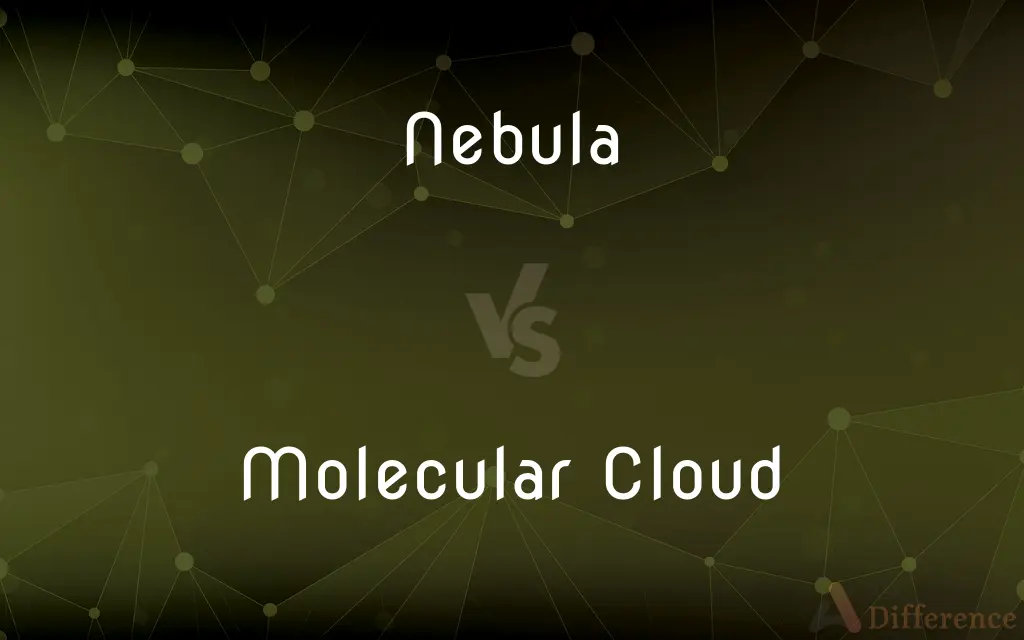Nebula vs. Molecular Cloud — What's the Difference?
Edited by Tayyaba Rehman — By Fiza Rafique — Published on December 19, 2023
A Nebula is a vast cloud of gas and dust in space, while a Molecular Cloud is a type of nebula with cold, dense gas where stars can form.

Difference Between Nebula and Molecular Cloud
Table of Contents
ADVERTISEMENT
Key Differences
A Nebula is a general term for any large cloud of gas and dust in space. On the other hand, a Molecular Cloud is a specific kind of nebula where gas is cool and dense enough to allow molecules to form.
Both Nebulae and Molecular Clouds play essential roles in the lifecycle of stars. While nebulae can be remnants of dead stars or birthplaces of new ones, Molecular Clouds are often the sites where stars begin their lives.
The primary distinction between a Nebula and a Molecular Cloud lies in their composition and conditions. Molecular Clouds are cold regions rich in molecules, whereas other types of nebulae might be hotter and ionized.
Observing a Nebula might reveal vibrant colors and intricate structures, reflecting various processes occurring within. In contrast, Molecular Clouds are often opaque to visible light due to their density, making them more evident in infrared or radio observations.
While all Molecular Clouds are nebulae, not all Nebulae are molecular clouds. The universe contains many types of nebulae, such as emission, reflection, and dark nebulae, with Molecular Clouds being just one category.
ADVERTISEMENT
Comparison Chart
Definition
A large cloud of gas and dust in space
A specific, cold, dense nebula with molecules
Temperature & Density
Can vary widely
Cold and dense
Role in Star Formation
Can be the birthplace or remnants of stars
Often the birthplace of new stars
Visibility in Different Lights
Visible in various spectra based on type
Mostly visible in infrared and radio waves
Composition
Can be ionized, molecular, or atomic gases
Dominated by molecular gases, especially H₂
Compare with Definitions
Nebula
A stellar nursery or remnant.
After the star exploded, it left behind a colorful nebula.
Molecular Cloud
Contains primarily molecular hydrogen (H₂).
The abundance of H₂ makes it a prime molecular cloud.
Nebula
A vast space cloud of gas and dust.
The Orion Nebula is a popular target for astronomers.
Molecular Cloud
A cold, dense nebula with abundant molecules.
Within the molecular cloud, new stars began to form.
Nebula
Interstellar matter congregated in a cloud.
Telescopes captured the intricate details of the nebula.
Molecular Cloud
Opaque to visible light due to its density.
Astronomers used infrared telescopes to peer inside the molecular cloud.
Nebula
Can be seen in various forms like planetary, reflection, or emission.
The Horsehead Nebula is a famous dark nebula.
Molecular Cloud
Often associated with regions of active star formation.
The molecular cloud was teeming with protostars and young suns.
Nebula
A diffuse cloud of interstellar dust or gas or both, visible as luminous patches or areas of darkness depending on the way the mass absorbs or reflects incident light or emits its own light.
Molecular Cloud
Often the birthplaces of stars.
Gravity caused regions of the molecular cloud to collapse and initiate star formation.
Nebula
A galaxy. No longer in technical use.
Nebula
A cloudy spot on the cornea.
Nebula
A liquid preparation for use in a nebulizer.
Nebula
(astronomy) A cloud in outer space consisting of gas or dust (e.g. a cloud formed after a star explodes).
Nebula
A white spot or slight opacity of the cornea.
Nebula
A cloudy appearance in the urine.
Nebula
A faint, cloudlike, self-luminous mass of matter situated beyond the solar system among the stars. The term was originally applied to any diffuse luminous region. Now, technically, it is applied to interstellar clouds of dust and gases (diffuse nebula). However distant galaxies and very distant star clusters often appear like them in the telescope, such as the spiral nebula in Andromeda, known now to be a distant galaxy.
Nebula
A white spot or a slight opacity of the cornea.
Nebula
A medicinal liquid preparation intended for use in an atomizer
Nebula
Cloudiness of the urine
Nebula
An immense cloud of gas (mainly hydrogen) and dust in interstellar space
Nebula
(pathology) a faint cloudy spot on the cornea
Nebula
Often illuminated by nearby stars.
The brightness of the nebula was due to the hot stars within.
Common Curiosities
Can stars form in any Nebula?
Not all nebulae are conducive to star formation; typically, stars form in Molecular Clouds.
Are Nebulae always associated with star birth or death?
While many are, nebulae can also exist in regions away from active star birth or death.
Are all Nebulae Molecular Clouds?
No, only a subset of nebulae are Molecular Clouds.
Are Molecular Clouds always dark?
In visible light, yes, but they emit in other wavelengths like infrared.
How do we observe a Molecular Cloud if they're opaque?
Molecular Clouds are primarily observed using infrared or radio wavelengths.
How does a Molecular Cloud lead to star formation?
The dense and cold conditions in a Molecular Cloud allow for gravitational collapse, leading to star formation.
Why are Molecular Clouds cold?
They are cold because of their dense gas, which shields the interior from external heat sources.
Why are some Nebulae colorful?
The colors in a Nebula arise from the emission of light by ionized gases or reflection of nearby starlight.
What causes the patterns and structures in a Nebula?
Stellar winds, radiation, gravitational interactions, and other forces can shape a Nebula.
What is the primary component of a Nebula?
A Nebula primarily consists of gas and dust in space.
What differentiates a reflection nebula from a Molecular Cloud?
A reflection nebula is a cloud of dust that reflects the light of nearby stars, while a Molecular Cloud is dense and cold with abundant molecules.
Can nebulae exist without any stars nearby?
Yes, while stars can influence nebulae, nebulae can also exist in interstellar space away from any significant starlight.
How large can a Molecular Cloud be?
Molecular Clouds can span hundreds of light-years across.
Can we find Molecular Clouds in any galaxy?
Yes, Molecular Clouds can be found in various galaxies wherever conditions permit.
Why is it called a Molecular Cloud?
It's called so because of the abundance of molecules, especially H₂, in the cloud.
Share Your Discovery

Previous Comparison
Absolute Poverty vs. Relative Poverty
Next Comparison
Endosome vs. LysosomeAuthor Spotlight
Written by
Fiza RafiqueFiza Rafique is a skilled content writer at AskDifference.com, where she meticulously refines and enhances written pieces. Drawing from her vast editorial expertise, Fiza ensures clarity, accuracy, and precision in every article. Passionate about language, she continually seeks to elevate the quality of content for readers worldwide.
Edited by
Tayyaba RehmanTayyaba Rehman is a distinguished writer, currently serving as a primary contributor to askdifference.com. As a researcher in semantics and etymology, Tayyaba's passion for the complexity of languages and their distinctions has found a perfect home on the platform. Tayyaba delves into the intricacies of language, distinguishing between commonly confused words and phrases, thereby providing clarity for readers worldwide.
















































